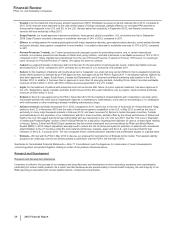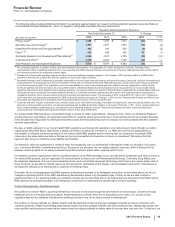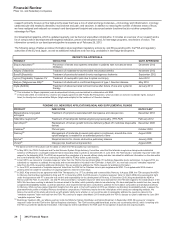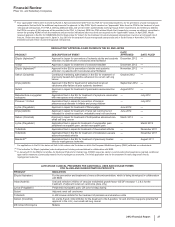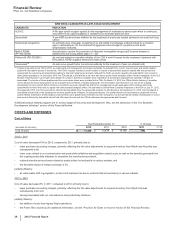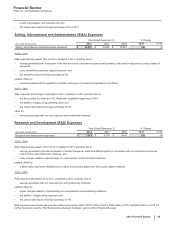Pfizer 2012 Annual Report Download - page 35
Download and view the complete annual report
Please find page 35 of the 2012 Pfizer annual report below. You can navigate through the pages in the report by either clicking on the pages listed below, or by using the keyword search tool below to find specific information within the annual report.
Financial Review
Pfizer Inc. and Subsidiary Companies
34
2012 Financial Report
not expected to have a significant negative impact on our results in 2013. The impact of the 2010 Act is recorded in Provision for taxes on
income. The expected impact in 2013 is reflected in our financial guidance for 2013.
On October 25, 2010, the Governor of Puerto Rico signed into law Act 154 to modify the Puerto Rico source-of-income rules and implement
an excise tax on the purchase of products by multinational corporations and their subsidiaries from their Puerto Rico affiliates that is effective
from 2011 through 2016. Act 154 had no impact on our results in 2010, since it did not become effective until 2011. Act 154 had a negative
impact on our results in 2011 and 2012. Act 154 will continue to negatively impact our results through 2016. The impact of Act 154 is recorded
in Cost of sales and Provision for taxes on income. The expected impact in 2013 is reflected in our financial guidance for 2013.
DISCONTINUED OPERATIONS
For additional information about our discontinued operations, see Notes to Consolidated Financial Statements—Note 2B. Acquisitions,
Divestitures, Collaborative Arrangements and Equity-Method Investments: Divestitures.
The following table provides the components of Discontinued operations—net of tax:
Year Ended December 31,(a)
(MILLIONS OF DOLLARS) 2012 2011 2010
Revenues $2,258 $2,673 $2,643
Pre-tax income/(loss) from discontinued operations 414 487 (50)
Provision/(benefit) for taxes on income(b) 117 137 (31)
Income/(loss) from discontinued operations––net of tax 297 350 (19)
Pre-tax gain/(loss) on sale of discontinued operations 7,123 1,688 (11)
Provision for taxes on income(c) 2,340 384 —
Gain/(loss) on sale of discontinued operations––net of tax 4,783 1,304 (11)
Discontinued operations—net of tax $5,080 $1,654 $(30)
(a) Includes the Nutrition business for all periods presented (through November 30, 2012) and the Capsugel business for 2011 (through August 1, 2011) and 2010
only. The net loss in 2010 includes the impairment of an indefinite-lived Brand intangible asset in the Nutrition business of approximately $385 million.
(b) Includes a deferred tax expense of $24 million for 2012, a deferred tax benefit of $43 million for 2011, and a deferred tax benefit of $156 million for 2010. These
deferred tax provisions include deferred income taxes related to investments in certain foreign subsidiaries, resulting from our intention not to hold these
subsidiaries indefinitely.
(c) Includes a deferred tax expense of $1.4 billion for 2012 and $190 million for 2011. These deferred tax provisions include deferred tax expense of $2.2 billion for
2012 and $190 million for 2011 on certain current-year funds earned outside the U.S. that will not be indefinitely reinvested overseas.
ADJUSTED INCOME
General Description of Adjusted Income Measure
Adjusted income is an alternative view of performance used by management, and we believe that investors’ understanding of our performance
is enhanced by disclosing this performance measure. We report Adjusted income in order to portray the results of our major operations––the
discovery, development, manufacture, marketing and sale of prescription medicines for humans and animals, consumer healthcare (over-the-
counter) products, and vaccines––prior to considering certain income statement elements. We have defined Adjusted income as Net income
attributable to Pfizer Inc. before the impact of purchase accounting for acquisitions, acquisition-related costs, discontinued operations and
certain significant items. The Adjusted income measure is not, and should not be viewed as, a substitute for U.S. GAAP net income.
The Adjusted income measure is an important internal measurement for Pfizer. We measure the performance of the overall Company on this
basis in conjunction with other performance metrics. The following are examples of how the Adjusted income measure is utilized:
• senior management receives a monthly analysis of our operating results that is prepared on an Adjusted income basis;
• our annual budgets are prepared on an Adjusted income basis; and
• senior management’s annual compensation is derived, in part, using this Adjusted income measure. Adjusted income is one of the
performance metrics utilized in the determination of bonuses under the Pfizer Inc. Executive Annual Incentive Plan that is designed to
limit the bonuses payable to the Executive Leadership Team (ELT) for purposes of Internal Revenue Code Section 162(m). Subject to the
Section 162(m) limitation, the bonuses are funded from a pool based on the achievement of three financial metrics, including adjusted
diluted earnings per share, which is derived from Adjusted income. Since 2011, this metric accounts for 40% of the bonus pool made
available to ELT members and other members of senior management and will constitute a factor in determining each of these individual’s
bonus.
Despite the importance of this measure to management in goal setting and performance measurement, Adjusted income is a non-GAAP
financial measure that has no standardized meaning prescribed by U.S. GAAP and, therefore, has limits in its usefulness to investors.
Because of its non-standardized definition, Adjusted income (unlike U.S. GAAP net income) may not be comparable to the calculation of
similar measures of other companies. Adjusted income is presented solely to permit investors to more fully understand how management
assesses performance.


